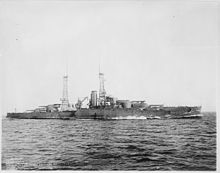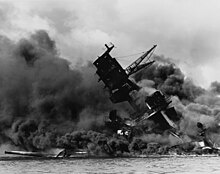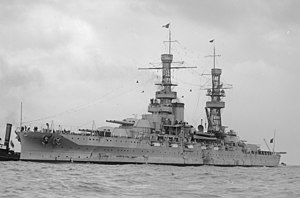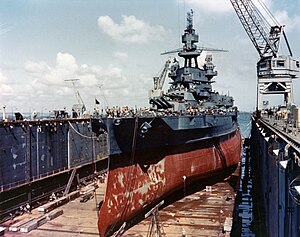Pennsylvania-class battleship
naval review in New York, December 1918
| |
| Class overview | |
|---|---|
| Name | Pennsylvania class |
| Builders | Newport News and New York |
| Operators | |
| Preceded by | Nevada class |
| Succeeded by | New Mexico class |
| Cost | $15,000,000[A] |
| Built | 1912–1916 |
| In commission | 1916–1946 |
| Completed | 2 |
| Lost | 1 |
| Retired | 1 |
| General characteristics (as built) | |
| Type | Dreadnought battleship |
| Displacement | |
| Length | |
| Beam | 97 ft 6 in (29.72 m) (waterline) |
| Draft | 29 ft 3 in (8.9 m) (deep load) |
| Installed power |
|
| Propulsion |
|
| Speed | 21.38 knots (39.60 km/h; 24.60 mph) (Pennsylvania's average on trials) |
| Range | 6,070 nmi (11,240 km; 6,990 mi) at cruising speed of 12 knots (22 km/h; 14 mph) |
| Complement | 55 officers and 860 men |
| Armament |
|
| Armor |
|
The Pennsylvania class consisted of two
The
In service, the Pennsylvania class saw limited use in the First World War, as a shortage of
Background

The preceding Nevada-class battleships represented a leap forward from previous American battleship technology and from most contemporary foreign designs. They were the first in the world to employ the "
In issuing desired specifications for the design that would become the Nevada class, the Navy's General Board asked for triple gun turrets, i.e., three guns mounted per turret. They were very unsatisfied with the awkward placement required on classes preceding the Nevadas, which had five and six two-gun turrets—yet moving back to the four two-gun turrets of the South Carolina class would be a significant loss in firepower. Although a triple turret was first proposed in American professional magazines in 1901 and briefly considered for the South Carolinas, it was not even in the experimental stage—the first turret was authorized in 1911 and would not be ready until months after contracts for the new ships would be signed with the shipbuilders. The decision to go ahead with the turret was a calculated gamble, but proved to be a qualified success; the only issue came with shell interference when the center and outside guns were fired simultaneously, which was easily solved by delaying the firing of the center barrel by a small fraction of a second. Moreover, there was a major benefit in weight thanks to the accompanying loss of an armored barbette and turret. These weight savings were applied to the armor protection, making the "all or nothing" concept a reality.[3]
The Nevadas were also the first American battleships to use exclusively
Design

The General Board's call for a new 1913 fiscal year battleship design was sent in June 1911 with the recent Nevada innovations in mind. They desired a ship with a main battery of twelve 14-inch guns in triple turrets, a secondary battery of twenty-two 5-inch (127 mm) guns, a speed of 21 knots (39 km/h; 24 mph), and armor equivalent to that of the Nevadas. The US Navy Bureau of Construction and Repair's (C&R) first sketch was unsatisfactory; their lengthy design of 625 feet (191 m) and 30,000 long tons (30,481 t) actually had less armor than the Nevadas, with a 12.5-inch (320 mm) belt.[5]
The design process was marked by various efforts to meet the General Board's specifications with only a moderate increase in tonnage over the Nevada class. Between January and March 1912, thirteen sketches were prepared for consideration by C&R with reciprocating or turbine engines that traded either speed or metacentric height for armor. Some later designs gave up a half knot of speed to free up about 500 long tons (508 t), enough to thicken the belt from 13.5 to 15 inches (343 to 381 mm) and the barbettes to 14 inches. The choice between double or triple turrets was also still an issue, as the Nevada class had not been completed yet. The Bureau of Ordnance was in favor of waiting for test results, rather than risking reverting to two-gun 14-inch turrets or moving up to two-gun 16-inch turrets.[6]
In March 1912, C&R proposed their seventh, eighth, ninth, and tenth designs to the General Board for approval. The eighth and ninth designs were the ones to give up a half knot of speed, while the tenth was a design with four triple turrets and 1,200 long tons (1,200 t) lighter than the Nevada-class ships. In April, the General Board chose the seventh design, which satisfied all of their requirements, albeit on the largest displacement, 31,300 long tons (31,800 t). The length was fixed at 630 feet (190 m), the beam at 93 feet (28 m), and the draft at 28.5 feet (8.7 m). Steam turbines gave the design 30,500 shaft horsepower (22,700 kW) and 21 knots, while the main armor belt was 13.5 inches tapering to 8 inches (203 mm) at the ends. This design was further refined and emerged in a completed state in September. The delay was partially due to tests on the proposed armor, which were completed in June 1912 and resulted in significant alterations to the Pennsylvania-class' underwater protection.[7]
Specifications
The Pennsylvania-class ships were significantly larger than their predecessors, the Nevada class. They had a
The ships had four
The Pennsylvania class carried twelve 14-inch/45
The Pennsylvania-class design continued the all-or-nothing principle of armoring only the most important areas of the battleships, which began in the preceding Nevada class. The waterline armor belt of
The main armor deck was three plates thick with a total thickness of 3 inches; over the steering gear the armor increased to 6.25 inches (159 mm) in two plates. Beneath it was the splinter deck that ranged from 1.5 to 2 inches (38 to 51 mm) in thickness.

Authorization and construction

The authorization for the two Pennsylvania-class ships faced political opposition for being too weak and expensive. Senator Benjamin Tillman believed that a much more capable warship was needed because of the shocking increase in battleship size over the previous few years—between 1907 (the Delaware class) and 1912, the displacement of American battleships increased by about fifty percent, from around 20,000 long tons (20,000 t) to 30,000 long tons.[18] Tillman proposed a "maximum battleship" in a Senate resolution in July 1912, which was adopted unanimously:
Resolved: That the Committee on Naval Affairs [is] instructed to investigate and report to the Senate ... the object being to find out from official sources the maximum size and maximum draft, the maximum armament, and the maximum armor to make the best battleship or cruiser the world has ever seen or ever will see; to have this country own the greatest marine engine of war ever constructed or ever to be constructed under known conditions; and to report whether one such overpowering vessel would not in its judgement be better for this country to build than to continue by increasing taxation to spend the millions and millions of dollars now in prospect in the race for naval supremacy. ... Let us leave some money in the Treasury for other more necessary and useful expenditures, such as good roads, controlling the floods in the Mississippi, draining swamp land in the South, and irrigating the arid land in the West. (S 361, 62nd Cong., 2nd sess.)[19]
Tillman's proposal was, in his own words, treated as a "joke"; the
Other politicians in Congress also had concerns with the navy's plans. The
Arizona was the one approved battleship for the fiscal year 1914. Secretary of the Navy George von Lengerke Meyer had requested three battleships for that fiscal year, citing the former policy of building two per year, plus an additional ship to make up for authorizing only Pennsylvania in the previous year, but congressional compromises once again approved only one new battleship. Arizona was authorized on 4 March 1913, but to avoid a lengthy delay between the two, the ship was ordered much more quickly, on 24 June, by giving the contract to a navy-owned shipyard.[24]
Pennsylvania was
The constructors were not able to meet these goals. Pennsylvania was launched on 16 March 1915, a full seventeen months after keel-laying, when she was just over two-thirds complete. Arizona was launched on 19 June 1915, about fifteen months after keel laying, when she weighed about 12,800 long tons (13,000 t).
Ships
| Ship name | Hull no. | Builder | Laid down | Launched | Commissioned | Decommissioned | Fate |
|---|---|---|---|---|---|---|---|
| Pennsylvania | BB-38 | Newport News Shipbuilding | 27 October 1913 | 16 March 1915 | 12 June 1916 | 29 August 1946 | Target ship, Operation Crossroads; scuttled 10 February 1948 |
| Arizona | BB-39 | New York Naval Shipyard
|
16 March 1914 | 19 June 1915 | 17 October 1916 | 29 December 1941 | Sunk during the attack on Pearl Harbor, 7 December 1941 |
Service histories

Pennsylvania and Arizona were commissioned during the
Pennsylvania and Arizona were given extensive modernizations from 1929 through 1931; the expenditure came in the fiscal year 1930.[41] As part of the rebuilding, Pennsylvania, which had been designed as a fleet flagship, had her conning tower expanded. Aside from that, Pennsylvania and Arizona received similar treatment: the elevation of the main batteries was increased to 30°, new fire control systems on tripod masts were added, the secondary armament and directors were replaced and overhauled, eight 5-inch/25 caliber anti-aircraft guns (four per side) were mounted on the weather deck which was above the secondary anti-ship 5-inch gun battery, and their bridges were enlarged to hold elevated anti-aircraft directors. Armor additions were comparatively minimal beyond anti-torpedo bulges, which were standard additions on all major warships in this period: 1.75 to 2 inches (44 to 51 mm) of armor were added to the second armored deck, and a torpedo bulkhead was added to the engine room. The propulsion system of the two Pennsylvanias received perhaps the most attention. The boiler system was entirely replaced with six small-tube boilers and new turbines, the latter partially from the cancelled Colorado-class battleship Washington. The new machinery allowed the ships to come close to their old design speed of 21 knots (39 km/h; 24 mph), even with the added bulk of bulges: Pennsylvania made 20.89 knots and Arizona 20.7 knots on full-power trials.[42]

After their modernization, both ships participated in the normal activities of the fleet, including
Pennsylvania came back into service more quickly than many of the other battleships present during the attack; she left on 20 December and was under repair in
For the next year, Pennsylvania provided shore bombardment during the Battles of Makin, Kwajalein, Eniwetok, and Saipan, along with the Palau Islands Campaign. The ship also participated in the landings on Leyte and the Battle of Leyte Gulf. During this time, Pennsylvania was present at the last battle ever between battleships, the Battle of Surigao Strait. The ship did not fire any salvos because the Japanese vessels were turned away or sunk at long range, beyond Pennsylvania's outdated fire control but within range of other, radar-directed battleships.[45]

In 1945, Pennsylvania was sent for another refit in San Francisco, and the guns in her main battery, worn out from the frequent shore bombardments, were replaced by those from Nevada and
With the
Footnotes
Endnotes
- ^ "Battleship 'Pennsylvania' and Class," Scientific American, 254.
- ^ Friedman, Design and Development, 65–66; Friedman, US Battleships, 101–02.
- ^ Friedman, Design and Development, 134–35; Friedman, US Battleships, 102, 107, 111.
- ^ Friedman, Design and Development, 93–95; Friedman, US Battleships, 102, 104–05.
- ^ Friedman, US Battleships, 113.
- ^ Friedman, US Battleships, 113–15.
- ^ Friedman, US Battleships, 114–15.
- ^ a b c d e f g Friedman, US Battleships, 440.
- ^ Stillwell, Battleship Arizona, 360.
- ^ Stillwell, Battleship Arizona, 305; "Trials of Our Latest Dreadnought," Scientific American, 297.
- ^ Friedman, US Battleships, 135.
- ^ Wright, "The US Navy's Study of the Loss of the Battleship Arizona," 66, 123, 285.
- ^ Friedman, US Battleships, 116, 440.
- ^ Campbell, Naval Weapons of World War II, 136.
- ^ Stillwell, Battleship Arizona, 19.
- ^ a b Stillwell, Battleship Arizona, 359.
- ^ a b Friedman, US Battleships, 115, 118, 440.
- ^ Friedman, US Battleships, 115–16.
- ^ United States Congressional Serial Set (Washington, DC: US Government Printing Office, 1916), 120.
- ^ Tillman and Moffet, Construction of Battleships, 3; "The Tillman Maximum Battleship," Advocate of Peace, 182.
- ^ Friedman, US Battleships, 148–49.
- ^ Friedman, US Battleships, 116; "Battleship Pennsylvania," Naval Engineers, 519.
- ^ "Battleship 'Pennsylvania' and Class," Scientific American, 254; "Saves $750,000 on New Battleship," The New York Times, 5 December 1913.
- ^ Friedman, US Battleships, 116.
- Pittsburg Press, 28 October 1913, 3.
- ^ "Lay Keel of Navy's New Dreadnought," The New York Times, 17 March 1914.
- ^ Stillwell, Battleship Arizona, 3–5.
- ^ "Navy to Build New Ship," Boston Evening Transcript, 13 June 1913, 6.
- ^ Barber, "Launching of the Battleship Arizona," 334.
- ^ "Battleship Pennsylvania," Naval Engineers, 519; "Recent Launches," International Marine Engineering, 180; "Prayer Launches Greatest Warship," The New York Times, 17 March 1915, 7; "50,000 to witness Arizona launching," The New York Times, 13 June 1915.
- ^ McCarthy, "Launching a Giant Battleship a Long-planned and Risky Job," 673–74.
- ^ Gill, "'Pennsylvania' Trials," 584.
- ^ "Trials of the Battleship Pennsylvania," International Marine Engineering, 189; "Trials of Our Latest Dreadnought," Scientific American, 297.
- ^ "The Pennsylvania Commissioned," The New York Times, 13 June 1916; "The Mighty Arizona Now a Part of Navy," The New York Times, 18 October 1918.
- ^ Stillwell, Battleship Arizona, 13–17.
- ^ "Pennsylvania", Dictionary of American Naval Fighting Ships.
- ^ Stillwell, Battleship Arizona, 18–21.
- ^ Jones, Battleship Operations, 28, 92.
- ^ Stillwell, Battleship Arizona, 37–38; Jones, Battleship Operations, 106.
- ^ "Pennsylvania" and "Arizona", Dictionary of American Naval Fighting Ships.
- ^ Friedman, US Battleships, 191, 197.
- ^ Friedman, US Battleships, 197–201.
- ^ Stillwell, Battleship Arizona, 274–76; Whitley, Battleships, 262; "Pennsylvania" and "Arizona", Dictionary of American Naval Fighting Ships.
- ^ Whitley, Battleships, 262.
- ^ Whitley, Battleships, 262–63.
- ^ Whitley, Battleships, 263; Cates, War History, 37–38.
- ^ Whitley, Battleships, 263; Cates, War History, 38; "Pennsylvania (BB 38)," Naval Vessel Register.
References
- "Arizona." Naval History & Heritage Command.
- "Battleship Pennsylvania." Journal of the American Society of Naval Engineers 27, no. 2 (1915): 519.
- Barber, G.H. "Launching of the Battleship Arizona," International Marine Engineering 20, no. 8 (1915): 334–36.
- Breyer, Siegfried. Battleships and Battle Cruisers, 1905–1970. Translated by Alfred Kurti. Garden City, NY: Doubleday, 1973. OCLC 702840.
- Campbell, John. Naval Weapons of World War II. Annapolis, MD: Naval Institute Press, 1985. ISBN 0-87021-459-4. OCLC 13085151.
- Cates Junior, Clifton B. War History of the USS Pennsylvania BB (38). N.p.: Ship's Welfare Fund, 1946. OCLC 6479199.
- Friedman, Norman. Battleship Design and Development, 1905–1945. New York: Mayflower Books, 1978. ISBN 0-8317-0700-3. OCLC 4505348.
- Friedman Norman. US Battleships: An Illustrated Design History. Annapolis, MD: Naval Institute Press, 1985. ISBN 0-87021-715-1. OCLC 12214729.
- Gill, C.C. "'Pennsylvania' Trials." Proceedings 42, no. 2 (1916): 584.
- Jones, Jerry W. US Battleship Operations in World War I. Annapolis, Maryland: Naval Institute Press, 1998. OCLC 37935228.
- McCarthy, J. Crosby. "Launching a Giant Battleship a Long-planned and Risky Job." Popular Mechanics 14, no. 5 (1915): 673–76.
- "Pennsylvania." Dictionary of American Naval Fighting Ships. Naval History & Heritage Command.
- "Recent Launches." International Marine Engineering 20, no. 4 (1915): 180.
- Stillwell, Paul. Battleship Arizona: An Illustrated History. Annapolis, Maryland: Naval Institute Press, 1991. ISBN 0-87021-023-8. OCLC 23654474.
- Tillman, Benjamin Ryan and William Adger Moffett. Construction of Battleships: Remarks of Hon. Benjamin R. Tillman ... United States Navy. 64th Cong., 1st sess., 20 June 1916. S. Doc 465.
- "Trials of the Battleship Pennsylvania." International Marine Engineering 21, no. 4 (1916): 189.
- "The Tillman Maximum Battleship." Advocate of Peace 74, no. 7 (1912): 182–83.
- "The United States Battleship 'Pennsylvania' and Class." Scientific American 111, no. 13 (1911): 244, 254.
- "Trials of Our Latest Dreadnought." Scientific American 114, no. 12 (1916): 297.
- Whitley, M.J. Battleships of World War Two: An International Encyclopedia. Annapolis, MD: Naval Institute Press, 1998. ISBN 1-55750-184-X. OCLC 40834665.
- Wright, Christopher C., ed. (2002–03). "The US Navy's Study of the Loss of the Battleship Arizona". Warship International 39–40 (3, 4, 1): 247–99, 360–80, 44–105.
External links
- USS Pennsylvania (BB-38, originally Battleship # 38), 1916–1948 (US Navy)
- USS Arizona (BB 39) (US Navy)
- Photo gallery of Pennsylvania-class battleship at NavSource Naval History
- Photo gallery of Pennsylvania-class battleship at NavSource Naval History


